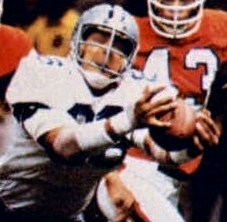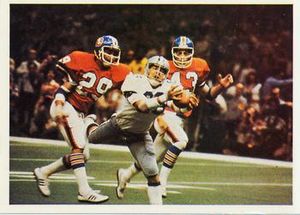Butch Johnson (American football) facts for kids

Johnson playing for the Cowboys in Super Bowl XII
|
|||||||||||
| No. 86 | |||||||||||
|---|---|---|---|---|---|---|---|---|---|---|---|
| Position: | Wide receiver | ||||||||||
| Personal information | |||||||||||
| Born: | May 28, 1954 Los Angeles, California, U.S. |
||||||||||
| Height: | 6 ft 1 in (1.85 m) | ||||||||||
| Weight: | 187 lb (85 kg) | ||||||||||
| Career information | |||||||||||
| High school: | Susan Dorsey (Los Angeles, California) |
||||||||||
| College: | UC Riverside | ||||||||||
| NFL Draft: | 1976 / Round: 3 / Pick: 87 | ||||||||||
| Career history | |||||||||||
|
|||||||||||
| Career highlights and awards | |||||||||||
|
|||||||||||
| Career NFL statistics | |||||||||||
|
|||||||||||
| Player stats at PFR | |||||||||||
Michael McColly "Butch" Johnson (born May 28, 1954) is a former American football player. He was a talented wide receiver in the National Football League (NFL). Butch played for the Dallas Cowboys and Denver Broncos. Before turning pro, he played college football for the UC Riverside Highlanders. The Cowboys picked him in the third round of the 1976 NFL draft.
Contents
Butch Johnson's Early Life and College Years
Butch Johnson grew up in Los Angeles, California. He went to Dorsey High School. There, he was great at both football and track. In 1972, he even took second place in the pole vault at a big city-wide meet.
He earned a sports scholarship to the University of California, Riverside. He joined their Division II team as a pole vaulter. In 1974, he was recognized as one of the best college football players.
In 1975, Butch was amazing at receiving. He caught 67 passes for 1,027 yards in just eight games. This made him the top receiver in the nation. He also earned All-American honors that year. After he graduated, the school stopped its football program. He finished his college career with 139 catches. He gained 2,106 yards and scored 17 touchdowns.
Years later, Butch was honored for his achievements. In 2012, he was added to the UCR Sports Hall of Fame. The next year, he joined the Riverside Sport Hall of Fame.
Butch Johnson's Professional Football Career
Playing for the Dallas Cowboys
The Dallas Cowboys chose Butch Johnson in the third round of the 1976 NFL draft. This was the 87th pick overall. In the 1978 season, he tied an NFL record. He had nine punt returns in one game against the Buffalo Bills. He also set a Cowboys team record. He had 45 punt returns for 489 yards that season.
In 1977, he shared playing time with another receiver. He caught 12 passes for 135 yards and one touchdown. He also set a team record with 50 punt returns. He led the team with 22 kickoff returns. His most famous moment came in Super Bowl XII. This was against the Denver Broncos. He made an amazing 45-yard diving touchdown catch. It was thrown by quarterback Roger Staubach. This play is still called a "Super Bowl Classic." Even with a broken thumb, he made the catch. A newspaper photo of it was titled "Outfielder Butch."
In 1978, he became the Cowboys' top punt returner. He broke his own record with 51 punt returns. He also scored another touchdown in Super Bowl XIII. The Cowboys lost that game to the Pittsburgh Steelers. But Butch became only the second player in NFL history. He scored touchdowns in two Super Bowls in a row.
In 1979, Butch missed the first five games. He broke his finger before the season started. His teammates, Tony Hill and Drew Pearson, had great seasons. This meant fewer chances for Butch. He started one game when Pearson was hurt. He caught a pass for a game-winning touchdown. This helped the Cowboys make the playoffs. He also stopped returning punts and kickoffs.
In 1981, he started the first six games. He filled in for an injured Hill. He finished the season with 25 catches for 552 yards. He also had 5 receiving touchdowns, tying for the team lead. During this time, he created a famous touchdown celebration. He called it the "California Quake." He would pretend to pull out guns and shake. It became one of the most well-known celebrations. This led the NFL to ban planned end-zone celebrations.
In 1983, Butch had his best year with 41 catches for 561 yards. But he wanted to be a starting receiver. So, he asked for a trade. In 1984, the Cowboys traded him to the Houston Oilers. They received Mike Renfro and some draft picks. One of those picks was used to get running back Herschel Walker.
Butch Johnson was known as one of the best backup receivers. He played eight seasons with the Cowboys. He was famous for his amazing and important catches. He left as the second-best punt returner in team history. He was also one of only two players to rank high in both kickoff and punt return averages.
Time with the Houston Oilers and Denver Broncos
In 1984, Butch joined the Houston Oilers. But his fun personality didn't fit in there. After three preseason games, the Oilers traded him. He went to the Denver Broncos.
With the Broncos, he reunited with his old coach, Dan Reeves. In 1984, he had a great year. He started 11 games. He caught 42 passes for 587 yards. He also scored 6 touchdowns. In one game against the New England Patriots, he caught 9 passes for 156 yards.
The next year, an injury slowed him down. He lost his starting spot. He played 8 games and caught 19 passes for 380 yards. He scored 3 touchdowns. But he didn't catch a single pass for six weeks late in the season. He was released by the Broncos in 1986.
Butch Johnson played in the NFL for 10 seasons. He caught 193 passes for 3,091 yards. He scored 28 touchdowns. He played in 5 NFC Championship Games and 2 Super Bowls. He also tied Super Bowl records. He had the most fumble recoveries in one game and in a career (2).
NFL Career Statistics
| Legend | |
|---|---|
| Won the Super Bowl | |
| Bold | Career high |
Regular season
| Year | Team | Games | Receiving | |||||
|---|---|---|---|---|---|---|---|---|
| GP | GS | Rec | Yds | Avg | Lng | TD | ||
| 1976 | DAL | 14 | 2 | 5 | 84 | 16.8 | 43 | 2 |
| 1977 | DAL | 14 | 0 | 12 | 135 | 11.3 | 22 | 1 |
| 1978 | DAL | 16 | 0 | 12 | 155 | 12.9 | 23 | 0 |
| 1979 | DAL | 11 | 1 | 6 | 105 | 17.5 | 28 | 1 |
| 1980 | DAL | 16 | 1 | 19 | 263 | 13.8 | 29 | 4 |
| 1981 | DAL | 16 | 7 | 25 | 552 | 22.1 | 55 | 5 |
| 1982 | DAL | 9 | 1 | 12 | 269 | 22.4 | 49 | 3 |
| 1983 | DAL | 16 | 5 | 41 | 561 | 13.7 | 46 | 3 |
| 1984 | DEN | 16 | 11 | 42 | 587 | 14.0 | 49 | 6 |
| 1985 | DEN | 16 | 8 | 19 | 380 | 20.0 | 65 | 3 |
| 144 | 36 | 193 | 3,091 | 16.0 | 65 | 28 | ||
Playoffs
| Year | Team | Games | Receiving | |||||
|---|---|---|---|---|---|---|---|---|
| GP | GS | Rec | Yds | Avg | Lng | TD | ||
| 1976 | DAL | 1 | 0 | 1 | 18 | 18.0 | 18 | 0 |
| 1977 | DAL | 3 | 1 | 2 | 53 | 26.5 | 45 | 1 |
| 1978 | DAL | 3 | 0 | 4 | 49 | 12.3 | 26 | 1 |
| 1979 | DAL | 1 | 0 | 1 | 3 | 3.0 | 3 | 0 |
| 1980 | DAL | 3 | 1 | 4 | 82 | 20.5 | 35 | 1 |
| 1981 | DAL | 2 | 1 | 1 | 20 | 20.0 | 20 | 0 |
| 1982 | DAL | 3 | 0 | 9 | 149 | 16.6 | 26 | 1 |
| 1983 | DAL | 1 | 0 | 3 | 20 | 6.7 | 12 | 0 |
| 17 | 3 | 25 | 394 | 15.8 | 45 | 4 | ||
Personal Life
Butch Johnson has some famous family members. His brother-in-law was the late singer and songwriter Bill Withers. Also, former Massachusetts Senator Edward Brooke is his second cousin.


